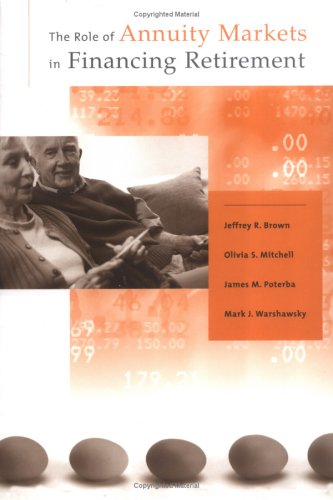The MIT Press
3 total works
The Role of Annuity Markets in Financing Retirement
by Jeffrey R. Brown, etc., Olivia S. Mitchell, James M Poterba, and Mark J. Warshawsky
Published 9 November 2001
Dramatic advances in life expectancy mean that today's retirees must plan on living into their eighties, their nineties, and even beyond. Longer life expectancies are the symbol of a prosperous society, but this progress also means that some retirees will need to plan conservatively and cut back substantially on their living standards or risk living so long that they exhaust their resources. This book examines the role that life annuities can play in helping people protect themselves against such outcomes.A life annuity is an insurance product that pays out a periodic amount for as long as the annuitant is alive, in exchange for a premium. The book begins with a history of life annuity markets during the twentieth century in the United States and elsewhere. It then explores recent trends in annuity pricing and money's worth, as well as the economic value generated for purchasers of these products. The book explains the potential importance of inflation-protected annuities and stock-market-linked variable annuities in providing more complete retirement security.
The concluding chapters examine life annuities in various institutional settings and the tax treatment of annuity products.
The concluding chapters examine life annuities in various institutional settings and the tax treatment of annuity products.
As members of the baby boom generation head into retirement, they face an economic environment that has changed noticeably since their parents retired. Most of these new retirees will not be equipped, as many in the earlier generation were, with private pension plans, early retirement options, and fully paid retiree health benefits in addition to Social Security and Medicare. Today it is increasingly left to retirees themselves to plan how to maximize retirement income and minimize risk. In Retirement Income, Mark Warshawsky and his colleagues describe strategies, products, and public policies that will help a new generation achieve financial security and income growth in retirement.
Warshawsky, a noted expert in the field who has worked in both government and private industry, analyzes two insurance vehicles, life annuities and long-term care insurance, and their capacity to protect against the extra costs arising from longevity and disability. He proposes two innovations. The first is a strategy that includes a set percentage withdrawal from a balanced portfolio, which is gradually used to purchase a ladder of life annuities. The second proposal, which includes a description of the potential choices in product design and available tax characteristics, is a product that integrates the immediate life annuity and long-term care insurance.
With Retirement Income, Warshawsky offers practical ideas based on the results of empirical investigations and analyses, which can be applied to household decision making by retirees and their financial planners and to the design of insurance products and public policy.
Warshawsky, a noted expert in the field who has worked in both government and private industry, analyzes two insurance vehicles, life annuities and long-term care insurance, and their capacity to protect against the extra costs arising from longevity and disability. He proposes two innovations. The first is a strategy that includes a set percentage withdrawal from a balanced portfolio, which is gradually used to purchase a ladder of life annuities. The second proposal, which includes a description of the potential choices in product design and available tax characteristics, is a product that integrates the immediate life annuity and long-term care insurance.
With Retirement Income, Warshawsky offers practical ideas based on the results of empirical investigations and analyses, which can be applied to household decision making by retirees and their financial planners and to the design of insurance products and public policy.
This book develops a consistent macroscopic theory of electromagnetism and discusses the relation between circuit theory and field theory. The theory is developed in successive steps from the Lorentz force, the integral form of Maxwell's equations in free space, and suitable macroscopic models of polarized and magnetized matter.Special features* Covers the electromagnetism of moving bodies and the process of electromechanical energy conversion* Introduces a power-series technique for analyzing quasi-static fields and quasi-stationary systems* Emphasizes the synthesis of fields as opposed to the analysis of fields* Presents, in an appendix, the four-dimensional relativistic formulation of macroscopic electrodynamics recently developed by one of the authors (L. J. Chu)

